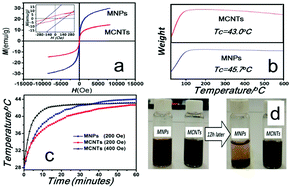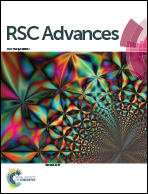Magnetic carbon nanotubes for self-regulating temperature hyperthermia †
Abstract
Magnetic hyperthermia can enhance the anti-tumor effects of chemotherapy. As carbon nanotubes are ideal drug carriers for chemotherapy, their combination with magnetic nanoparticles provides a novel chance for multi-modal thermo-chemotherapy. Most related work focuses on attaching Fe3O4 nanoparticles on carbon nanotubes, however the hyperthermia temperature for this combination can not be self-regulated due to the high Curie temperature of Fe3O4. In this work, magnetic Zn0.54Co0.46Cr0.6Fe1.4O4 nanoparticles with low Curie temperature were attached onto carbon nanotubes to obtain the magnetic carbon nanotubes. The morphology, formation mechanism, magnetic properties, heat generation ability and cytotoxicity of the magnetic carbon nanotubes were investigated. These magnetic carbon nanotubes show a Curie temperature of 43 °C and a self-regulating temperature at 42.7 °C under clinically applied magnetic field conditions (frequency: 100 kHz, intensity: 200 Oe). The evaluation of in vitro cytotoxicity suggests no obvious toxicity effects under the concentrations of 6.25 μg ml−1 to 100 μg ml−1. This study proposed a methodology for the bespoke synthesis of magnetic carbon nanotubes with a low Curie temperature for self-regulating magnetic hyperthermia, which may be used for further research on loading drugs for multi-modal cancer therapy.



 Please wait while we load your content...
Please wait while we load your content...